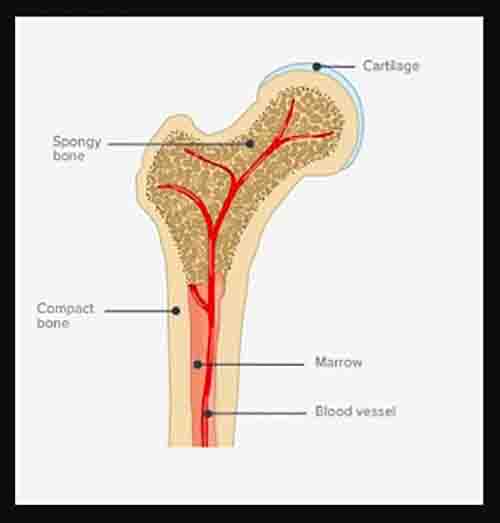Spongy Bone Definition
An animal’s spongy bone, also known as cancellous bone or trabecular bone, is very porous. It contains red bone marrow and is highly vascularized. A spongey bone is usually found at the end of a long bone (the epiphyses), surrounded by a harder, compact bone.
As well as the vertebrae, the ribs, the skull, and the joints, it is also found inside them. Compared to compact bone, spongy bone is weaker and softer. Trabeculae (Latin for little beams) give it its spongy appearance by forming a lattice-like matrix network.
Structure of Spongy Bone
Sprongy bones contain tiny cavities called lacunae where cells called osteoocytes reside. Along with the bone marrow, lacunae and their accompanying osteocytes are found in the trabeculae matrix of the bone. Through the harder, compact bone, blood vessels carry the materials necessary to create blood cells to the softer, spongy bone.
Through tiny interconnected channels on the surface of the trabeculae, osteoclasts close to blood vessels can absorb nutrients and expel waste products. By secreting the material that forms compact bone matrix, osteoblasts can convert spongy bone to compact bone. In a human embryo, long bones develop through this process.
Functions of Spongy Bone
Storage of Bone Marrow
Trabecular matrix crowds blood vessels together and condenses them into bone marrow, also called myeloid tissue. In contrast to compact bone, spongy bone has a lattice-like network of trabeculae that helps make and store bone marrow.
Yellow bone marrow, which is primarily composed of fat, is stored in the medullary cavity of compact bones. Red bone marrow is found in spongy bones, which are used in erythropoiesis.
Site of Erythropoiesis
Red blood cells are produced in the red bone marrow of spongy bone at a rate of about 2 million per second. The spongy bone’s highly vascularized nature allows it to deliver adequate amounts of glucose, lipids, amino acids, and trace elements for red blood cell production.
Macrophages phagocytize old and damaged red blood cells in the bone marrow when they are ready to die. The liver and spleen also undergo this process.
Reduces the Weight of the Skeleton
In order to reduce the overall weight of the skeleton, the lighter, less dense spongy bones balance out the heavier and denser compact bones. As a result, muscles are able to move the limbs more easily.
Adds Strength and Flexibility to Bones
As trabeculae form along lines of stress, spongy bones become flexible and strong. Our joints also contain spongy bones, which act as shock absorbers when we walk, run, and jump.
Mineral Storage
99% of the calcium and 85% of the phosphorus in the human body are stored in the skeleton. Muscles and the nervous system require a tightly regulated mineral content in the blood. Minerals are released into the bloodstream rapidly when needed, and hormones are often involved in this process.
Evolutionary Changes in Human Spongy Bone
Modern human skeletons have a low trabecular density compared to their size. Human skeletons contain around 20% spongy bone. Compared to humans, chimpanzees’ skeletons are almost entirely made up of spongy bone. A higher percentage of spongy bone was found in early human bones than in modern humans.
Recent research has investigated this finding further by comparing the trabecular density of modern human skeletons with those of chimpanzees and early humans. A study was conducted to determine when human trabecular bone density decreased in evolution. As a result of increasingly sedentary lifestyles and technological reliance, modern humans have a lower trabecular bone density than their ancestors.

